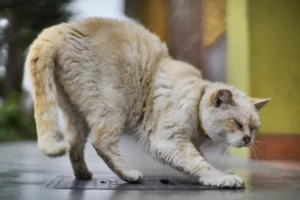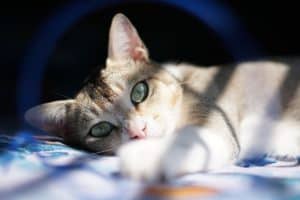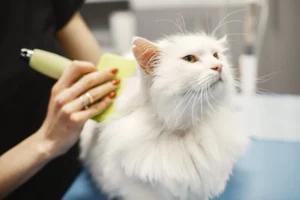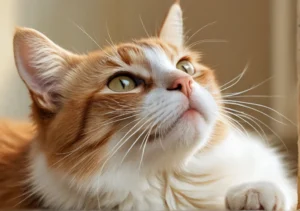Cats have a reputation for being curious and fearless creatures, but when it comes to cat masks, their reaction can be quite the opposite. Why are cats afraid of cat masks? Let’s explore this intriguing behavior and uncover the reasons behind it.
The Psychological Response of Cats to Masks
Have you ever wondered why cats seem to freak out when they see someone wearing a cat mask? It turns out that there’s a pretty deep psychological reason for their reactions. Cats rely heavily on non-verbal cues and facial expressions to communicate, so when they see a mask covering a person’s face, it can be extremely confusing for them. They may struggle to interpret the masked face, leading to feelings of fear or anxiety.
Additionally, cats are creatures of habit, and they thrive on routine and familiarity. When they encounter something as unusual as a cat mask, it disrupts their sense of safety and security. The sudden change in appearance can trigger their fight-or-flight response, causing them to react with caution or fear.
Evolutionary Instincts at Play
To truly understand why cats are afraid of cat masks, we need to delve into their evolutionary history. Cats are natural hunters, and their survival depends on being able to quickly assess potential threats in their environment. When they see a mask that resembles another cat, their instinctual response is to be wary and on high alert.
This fear can be traced back to their ancestors, who needed to be constantly vigilant to avoid predators and other dangers. The sight of a masked face may trigger their ancient survival instincts, causing them to respond with fear and apprehension.
Extra Tip: To help your cat feel more at ease around cat masks, gradually introduce them to the mask in a calm and controlled environment. Reward them with treats and praise for positive behaviors to help them associate the mask with positive experiences.
Sensory Overload: Sight, Smell, and Sound
Cats are incredibly sensory creatures, relying on their keen senses of sight, smell, and sound to navigate the world around them. When confronted with a cat mask, the unique features of these masks can overwhelm a cat’s perception. The exaggerated facial features and unfamiliar shapes can be confusing and intimidating to a cat, causing them to feel uneasy and anxious.
Furthermore, the scent of a cat mask may be unfamiliar and potentially alarming to a cat. Cats rely heavily on their sense of smell to identify objects and individuals, and a foreign scent emanating from a mask can trigger a fear response in cats.
Additionally, the sound of a mask rustling or moving can startle cats. Cats are attuned to subtle sounds in their environment, and the unnatural noises produced by a mask can be distressing to them.
Overall, the sensory overload caused by cat masks can make cats fearful and uncomfortable in their presence.
The Concept of Threat and Safety
Cats have a strong instinct for self-preservation and are constantly evaluating objects and situations for potential threats. When cats encounter unfamiliar objects like cat masks, they may perceive them as a potential threat to their safety.
Cats distinguish between familiar and unfamiliar objects based on familiarity and past experiences. Anything new or unusual can trigger their instinctual fight-or-flight response, with cat masks falling into the category of unfamiliar objects that may pose a threat.
The exaggerated features and unusual appearance of cat masks can be unsettling to cats, as they struggle to categorize them as safe or dangerous. This ambiguity can lead cats to err on the side of caution and view cat masks as a possible threat, prompting fear and avoidance behaviors.
By understanding how cats perceive and categorize objects based on threat levels, we can better appreciate why they may be afraid of cat masks. It’s essential to respect their instincts and create a safe environment for them to feel secure and at ease.
Behavioral Cues: Body Language and Vocalizations
Cats are sensitive creatures, and they express their emotions through subtle cues in their body language and vocalizations. When faced with something that triggers fear or anxiety, like a cat mask, they may exhibit signs of distress. Look out for flattened ears, dilated pupils, a stiff and tense body posture, or hissing and growling sounds. These are clear indicators that your furry friend is feeling uneasy and scared. By understanding these behavioral cues, you can help alleviate their fear and create a secure environment for them.
Overcoming Fear: Desensitization Techniques
One effective way to help cats overcome their fear of cat masks is through desensitization techniques. Gradual exposure to the object of their fear combined with positive reinforcement can make a significant difference. Start by introducing the cat mask from a distance, allowing your cat to approach it at their own pace. Pair this exposure with treats or playtime to create positive associations. Over time, gradually decrease the distance between your cat and the mask until they are comfortable being near it. Consistent and patient desensitization can help your furry friend conquer their fear and build confidence.
Desensitization Tips: 1. Start with the cat mask at a distance and gradually bring it closer. 2. Offer treats or playtime during exposure to create positive associations. 3. Maintain a calm and reassuring demeanor to help your cat feel safe. 4. Be patient and allow your cat to progress at their own pace. 5. Seek professional help if your cat’s fear persists despite desensitization efforts.
Real-Life Examples and Testimonials
Have you ever seen a cat’s reaction to a cat mask? Some cat owners have shared fascinating insights into their feline friends’ behaviors when faced with this unusual object. One owner described how their cat hissed and arched its back in fear when they wore a cat mask for Halloween, showcasing a clear aversion to the unfamiliar sight. Another owner mentioned that their cat retreated to a corner and refused to come near them while wearing the mask, highlighting a strong instinctual response to potential danger. These real-life examples shed light on the genuine fear that cats may experience when confronted with cat masks.
The Impact of Environment on Cats’ Reactions
The environment in which a cat is raised plays a crucial role in shaping their reactions to unusual stimuli like cat masks. Cats who have been exposed to a variety of objects, noises, and experiences from a young age are more likely to exhibit curiosity and adaptability when encountering new items. On the other hand, cats that have had limited exposure to different stimuli may be more prone to fear and anxiety when faced with unfamiliar objects. Therefore, providing a rich and diverse environment for your cat to explore can help them build confidence and resilience, reducing their fear response to cat masks and other novel items.
Key Tips for Helping Cats Overcome Fear of Cat Masks:
– Gradual Exposure: Introduce the cat mask gradually, starting with placing it in a familiar environment for the cat to investigate at their own pace.
– Positive Reinforcement: Reward your cat with treats or affection when they show calm behavior around the mask, encouraging positive associations.
– Play Therapy: Incorporate the mask into interactive play sessions to help your cat see it as a harmless object rather than a threat.
– Consult a Professional: If your cat’s fear persists, seek advice from a veterinarian or animal behaviorist to develop a tailored plan for desensitization and overcoming fear.
Quirky Cat Behaviors: Anecdotes and Trivia
Did you know that cats can be scared of the most unexpected things, like cat masks? Yep, you heard it right! But why is that? It all comes down to their keen sense of smell and instinctual behaviors. Cats rely heavily on their sense of smell to navigate the world around them, and when they come across something that doesn’t quite smell right, like a cat mask, it can trigger fear and anxiety in them.
Cats are known to be territorial creatures, and anything that changes their familiar environment can set off their alarm bells. Cat masks, with their unfamiliar scents and strange appearances, can be perceived as a potential threat by our feline friends. This reaction is simply their way of protecting themselves and staying safe in their surroundings.
So, the next time you see your cat darting away from a harmless cat mask, remember that it’s just their instincts kicking in. Give them some space and time to investigate the object on their terms, and they’ll likely come around once they realize it’s nothing to be afraid of. After all, cats are complex creatures with unique behaviors that never fail to surprise and entertain us!
Additional Insight:
- It’s essential to introduce new objects or scents slowly to your cat to prevent fear or anxiety reactions. Gradually acclimating them to unfamiliar items can help reduce their stress and build their confidence in exploring new things.
Alex, a passionate animal lover, has experience in training and understanding animal behavior. As a proud pet parent to two dogs and three cats, he founded AnimalReport.net to share insights from animal experts and expand his knowledge of the animal kingdom.




